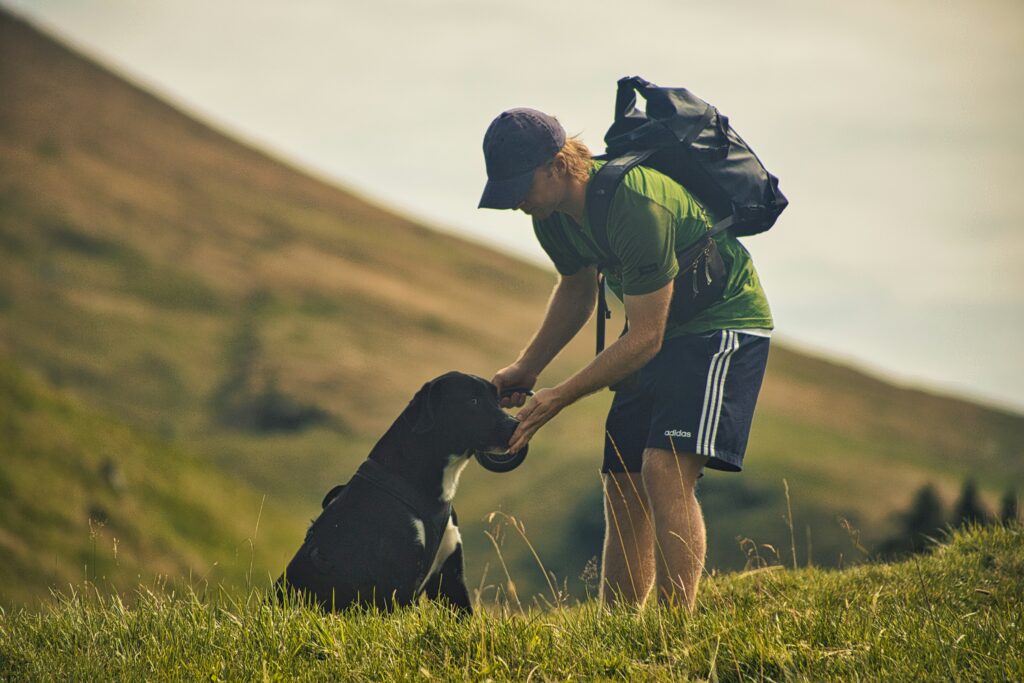
Training a dog for longer hikes begins with shaping a mindset that allows them to explore the outdoors with confidence and composure. While most dogs enjoy being outside, long hikes demand more than simple enthusiasm—they require emotional steadiness and the ability to remain focused even when everything around them is unfamiliar. Building this mindset starts with short and gentle outdoor sessions. Taking the dog on peaceful trails, quiet parks, and open natural areas gradually introduces them to new experiences. These outings allow the dog to sniff different scents, hear new sounds, and adjust to the movement of nature without feeling overwhelmed.
The handler plays a vital role in reinforcing calm behavior during these early outings. Rewarding the dog for staying close, responding to simple cues, and keeping a relaxed pace helps build a connection of trust. When distractions appear—whether it’s a passing jogger, a nearby bird flapping, or a distant dog barking—the handler offers reassurance through a soothing tone or a cue that directs attention. These experiences help the dog understand that they can rely on their handler for guidance. Over time, the dog becomes more confident, learns to process stimulation more thoughtfully, and builds the emotional foundation needed for longer, more demanding hikes.
Building Endurance, Strength, and Physical Confidence
A dog’s physical readiness is essential for success on longer hikes, and conditioning should be gradual and consistent. The process begins with regular walks that gradually increase in length. Once the dog is comfortable with moderate distances, the handler starts introducing terrain changes, such as small slopes, forest paths, uneven ground, and grassy hills. These natural variations build muscle strength and joint stability while also improving balance. The dog learns to move with more awareness, adjusting their steps when the ground is slippery, soft, or filled with natural obstacles.
Pacing is another core element of physical conditioning. Rather than allowing the dog to sprint ahead when excited, the handler teaches them to maintain a slow and steady rhythm. This prevents early exhaustion and helps the dog learn to conserve energy for longer journeys. Hydration routines are introduced early, with water breaks scheduled throughout training sessions. This teaches the dog to pause and drink regularly, which becomes critical during long hikes. Training during cooler times of the day reduces the risk of overheating, and planned rest days give muscles the chance to recover. With consistent practice, the dog develops strong endurance, healthy stamina, and the physical confidence needed to face extended outdoor adventures.
Strengthening Obedience, Trail Safety, and Reliable Behavior
A successful hiking dog responds reliably to cues and behaves safely in a variety of situations. Obedience training is therefore essential. Commands such as heel, come, stay, leave-it, and wait form the foundation for safety on the trail. Training begins in predictable environments where the dog can focus easily. Once they respond consistently, sessions shift to more stimulating outdoor areas where distractions like scents, movement, and noise are present. This helps the dog learn to remain attentive even amid new experiences. A strong, dependable recall is significant in case of unexpected encounters with wildlife or sudden trail changes.
Trail manners complement obedience training by teaching the dog how to interact respectfully with others. The dog learns to move aside politely when hikers or cyclists approach, remain calm when other dogs pass, and navigate narrow or busy paths without pulling. Exposure to small natural challenges—such as stepping over roots, walking through shallow water, or moving carefully across rocky patches—improves the dog’s ability to navigate terrain safely. Practicing these behaviors helps build a sense of responsibility and control, turning the dog into a dependable partner capable of handling long hikes with good manners and awareness.
Introducing Gear and Helping the Dog Adapt to Equipment
Gear training prepares the dog to stay safe and comfortable during extended hikes. A well-fitted hiking harness is typically the first piece of equipment introduced. Unlike a regular collar, a hiking harness distributes pressure evenly across the dog’s body, providing better control and reducing neck strain. Once the dog becomes comfortable wearing the harness, hiking boots can be introduced to protect their feet from rough terrain. Many dogs initially find boots unfamiliar and may walk stiffly or shake their paws, so short indoor practice sessions help them adjust before wearing them on real trails.
A dog backpack becomes useful once the dog has built enough strength and coordination. Starting with an empty pack allows the dog to get used to carrying weight. Gradually, small, lightweight items can be added, ensuring the load remains minimal. Reflective accessories, cooling gear, collapsible bowls, and hands-free leashes are introduced separately so the dog feels comfortable with each item. When gear is incorporated slowly and positively, the dog learns to associate it with adventure rather than stress. This preparation ensures that the dog feels secure and supported during long hikes.
Developing Mental Stability, Trail Intelligence, and Problem-Solving Skills
Long hikes challenge a dog’s mind as much as their body, and mental conditioning helps them handle the unexpected. Mental resilience is built through small exercises that encourage focus and thoughtful movement. Activities such as stepping over low obstacles, weaving through markers, balancing briefly on flat stones, or navigating around natural barriers develop coordination and decision-making. These exercises mimic the challenges dogs may encounter on trails, teaching them to approach obstacles with confidence rather than hesitation.
Scent-based exercises and exploration games further strengthen mental endurance. Allowing the dog to track scents, search for hidden treats, or explore new environments helps sharpen concentration and awareness. Controlled exposure to dynamic elements—such as moving water, wildlife activity, or rustling leaves—teaches the dog to interpret sensory input calmly. Through positive reinforcement, the dog begins to view unfamiliar situations as opportunities rather than threats. With these mental skills in place, the dog can navigate long hikes with steady focus, adaptability, and confidence, making them a reliable companion on every trail.